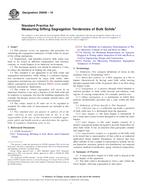We need your consent to use the individual data so that you can see information about your interests, among other things. Click "OK" to give your consent.
ASTM D6940-10
Standard Practice for Measuring Sifting Segregation Tendencies of Bulk Solids
STANDARD published on 1.7.2010
The information about the standard:
Designation standards: ASTM D6940-10
Note: WITHDRAWN
Publication date standards: 1.7.2010
SKU: NS-37077
The number of pages: 5
Approximate weight : 15 g (0.03 lbs)
Country: American technical standard
Category: Technical standards ASTM
The category - similar standards:
Annotation of standard text ASTM D6940-10 :
Keywords:
bulk solids, segregation, sifting, Segregation, Bulk solids, Horizontal testing, Sifting segregation, ICS Number Code 19.120 (Particle size analysis. Sieving)
Additional information
| Significance and Use | ||||||||
|
Sifting segregation can cause horizontal segregation (for example, center-to-periphery) within bins used to hold and transport bulk solids. This can affect final product quality in industrial applications. By measuring a bulk solid's segregation tendency, one can compare results to other bulk solids with known history, or determine if the given bulk solid may have a tendency to segregate in a given process. Sifting, which is a process by which smaller particles move through a matrix of larger ones, is a common method of segregation. Four conditions must exist for sifting to occur: A Difference in Particle Size between the Individual Components—This ratio can be as low as 1.3 to 1. In general, the larger the ratio of particle sizes, the greater the tendency for particles to segregate by sifting. A Sufficiently Large Mean Particle Size—Sifting segregation can occur with a mean particle size in the 50 μm range and can become a dominant segregation mechanism if the mean particle size is above 100 μm. Sufficiently Free Flowing Material—This allows the smaller particles to sift through the matrix of larger particles. With cohesive materials, the fine particles are bound to one another and do not enter the voids among the coarse particles. Interparticle Motion—This can be caused during formation of a pile, by vibration, or by a velocity gradient across the flowing material. All four of these conditions must exist for sifting segregation to occur. If any one of these conditions does not exist, the material will not segregate by this mechanism. Note 1—The quality of the result produced by this practice is dependent on the competence of the personnel performing it, and the suitability of the equipment and facilities used. Agencies that meet the criteria of Practice D3740 are generally considered capable of competent and objective testing/sampling/inspection/etc. Users of this practice are cautioned that compliance with Practice D3740 does not in itself assure reliable results. Reliable results depend on many factors; Practice D3740 provides a means of evaluating some of those factors. Practice D3740 was developed for agencies engaged in the testing and/or inspection of soil and rock. As such it is not totally applicable to agencies performing this practice. However, users of this practice should recognize that the framework of Practice D3740 is appropriate for evaluating the quality of an agency performing this practice. Currently there is no known qualifying national authority that inspects agencies that perform this practice. |
||||||||
| 1. Scope | ||||||||
|
1.1 This practice covers an apparatus and procedure for simulating the segregation tendencies of bulk solids by means of the sifting mechanism. 1.2 Temperature- and humidity-sensitive bulk solids may need to be tested at different temperatures and moisture contents, as would happen in an industrial environment. 1.3 The maximum particle size should be limited to 3 mm, to reduce the likelihood of binding the slide gate. 1.4 This standard is not applicable to all bulk solids and segregation mechanisms: while sifting is a common segregation mechanism experienced by many bulk solids, other segregation mechanisms not evaluated by this standard might induce segregation in practice. Practice D6941 covers another common mechanism: fluidization. 1.5 The extent to which segregation will occur in an industrial situation is not only a function of the bulk solid and its tendency to segregate, but also the handling equipment (for example, bin design), process (for example, transfer rates), and environment. 1.6 The values stated in SI units are to be regarded as standard. No other units of measurement are included in this standard. 1.7 This standard does not purport to address all of the safety concerns, if any, associated with its use. It is the responsibility of the user of this standard to establish appropriate safety and health practices and determine the applicability of regulatory limitations prior to use. |
||||||||
| 2. Referenced Documents | ||||||||
|



 Cookies
Cookies
